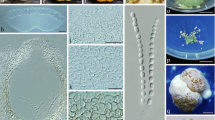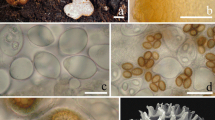Abstract
Two new species of the fungal genus Trichoderma, Trichoderma compactum and Trichoderma yunnanense, isolated from rhizosphere of tobacco in Yunnan Province, China are described based on morphological characters and phylogenetic analyses of nucleotide sequences. Our DNA sequences included the internal transcribed spacer (ITS) regions of the rDNA cluster (ITS1 and ITS2), and partial sequences of the translation elongation factor 1-alpha (tef1) and a fragment of the gene coding for endochitinase 42 (ech42). The analyses show that T. compactum belongs to the Harzianum clade, and T. yunnanense belongs to the Hamatum clade.



Similar content being viewed by others
References
Bissett J (1991a) A revision of the genus Trichoderma.II. Infrageneric classification. Can J Bot 69:2357–2372
Bissett J (1991b) A revision of the genus Trichoderma.III. Sect. Pachybasium. Can J Bot 69:2373–2417
Bissett J (1991c) A revision of the genus Trichoderma. IV. Additional notes on section Longibrachiatum. Can J Bot 69:2418–2420
Bissett J, Szakacs G, Nolan CA et al (2003) New species of Trichoderma from Asia. Can J Bot 81:570–586
Chaverri P, Samuels GJ, Stewart EL (2001) Hypocrea virens sp. nov., the teleomorph of Trichoderma virens. Mycologia 93:1113–1124
Chaverri P, Castlebury LA, Samuels GJ et al (2003a) Multilocus phylogenetic structure within the Trichoderma harzianum / Hypocrea lixii complex. Mol Phylogenet Evol 27:302–313
Chaverri P, Castlebury LA, Overton BE et al (2003b) Hypocrea / Trichoderma: species with conidiophore elongations and green conidia. Mycologia 95:1100–1140
Dodd SL, Lieckfeldt E, Samuels GJ (2003) Hypocrea atroviridis sp.nov., the teleomorph of Trichoderma atroviride. Mycologia 95:27–40
Druzhinina IS, Kopchinskiy A, Kubicek CP et al (2006) The first 100 Trichoderma species characterized by molecular data. Mycoscience 47:55–64
Elad Y, Chet I, Henis Y (1981) An selective medium for improving quantitative isolation of Trichodermaspp. from soil . Phytoparasitica 9:59–67
Gams W, Bissett J (1998) Morphology and identification of Trichoderma. In: Kubicek CP, Harman GE (eds) Trichoderma and Gliocladium Basic biology, Taxonomy and Genetics, vol 1. Taylor and Francis, London, pp 3–34
Kindermann J, El-Ayouti Y, Samuels GJ et al (1998) Phylogeny of the genus Trichoderma based on sequence analysis of the internal transcribed spacer region 1 of the rDNA clade. Fungal Genet Biol 24:298–309
Kraus GF, Druzhinina I, Gams W et al (2004)Trichoderma brevicompactum sp. nov. Mycologia 96:1059–1073
Kubicek CP, Bissett J, Druzhinina I et al (2003) Genetic and metabolic diversity of Trichoderma: a case study on South–East Asian isolates. Fungal Genet Biol 38:310–319
Kullnig CM, Szakacs G, Kubicek CP (2002) Phylogeny and evolution of the genus Trichoderma: a multigene approach. Mycol Res 106:757–767
Lu BS, Druzhinina IS, Fallah P et al (2004) Hypocrea/Trihcoderma species with pachybasium-like conidiophores: teleomorphs for T. minutisporum and T. polysporum and their newly discovered relatives. Mycologia 96:310–342
Samuels GJ (1996) Trichoderma: a review of biology and systematics of the genus. Mycol Res 100:923–935
Samuels GJ, Lieckfeldt E, Nirenberg HI (1999) Trichoderma asperellum, a new species with warted conidia, and redescription of Trihcoderma viride. Sydowia 51:71–88
Samuels GJ, Suarez C, Solis K et al (2006) Trichoderma theobromicola and T. paucisporum: two new species isolated from cacao in South America. Mycol Res 110:381–392
Samuels GJ (2006b) Trichoderma: systematics, the sexual state, and ecology. Phytopathology 96:195–206
Swofford DL (2002) PAUP. Phylogenetic analysis using parsimony, Version 4.0. Sinauer Associate, Sunderland, Massachusetts, USA
Turner D, Kovacs W, Kuhls K et al (1997) Biogeography and phenotypic variation in Trichoderma sect. Longibrachiatum and associated Hypocrea species. Mycol Res 101:449–459
White TJ, Bruns T, Lee S et al, (1990) Amplification and direct sequencing of fungal ribosomal RNA genes for phylogenetics. In: Innis MA, Gelfand DH, Sninsky JJ, et al (eds) PCR protocols: a guide to methods and applications. Academic Press, San Diego CA, pp 315–322
Zhang CL, Druzhinina IS, Kubicek CP et al (2005) Trichoderma biodiversity in China: Evidence for a North to South distribution of species in East Asia. FEMS Microbiol Lett 251:251–257
Acknowledgements
We thank Prof. John Bissett and Prof. JianPing Xu for their detailed comments on this paper. This work was funded by projects from Ministry of Science and Technology of PR China (2003CB415102) and the Department of Science and Technology of Yunnan Province (approved no. 2005NG05).
Author information
Authors and Affiliations
Corresponding author
Rights and permissions
About this article
Cite this article
Yu, ZF., Qiao, M., Zhang, Y. et al. Two new species of Trichoderma from Yunnan, China. Antonie van Leeuwenhoek 92, 101–108 (2007). https://doi.org/10.1007/s10482-006-9140-4
Received:
Accepted:
Published:
Issue Date:
DOI: https://doi.org/10.1007/s10482-006-9140-4




